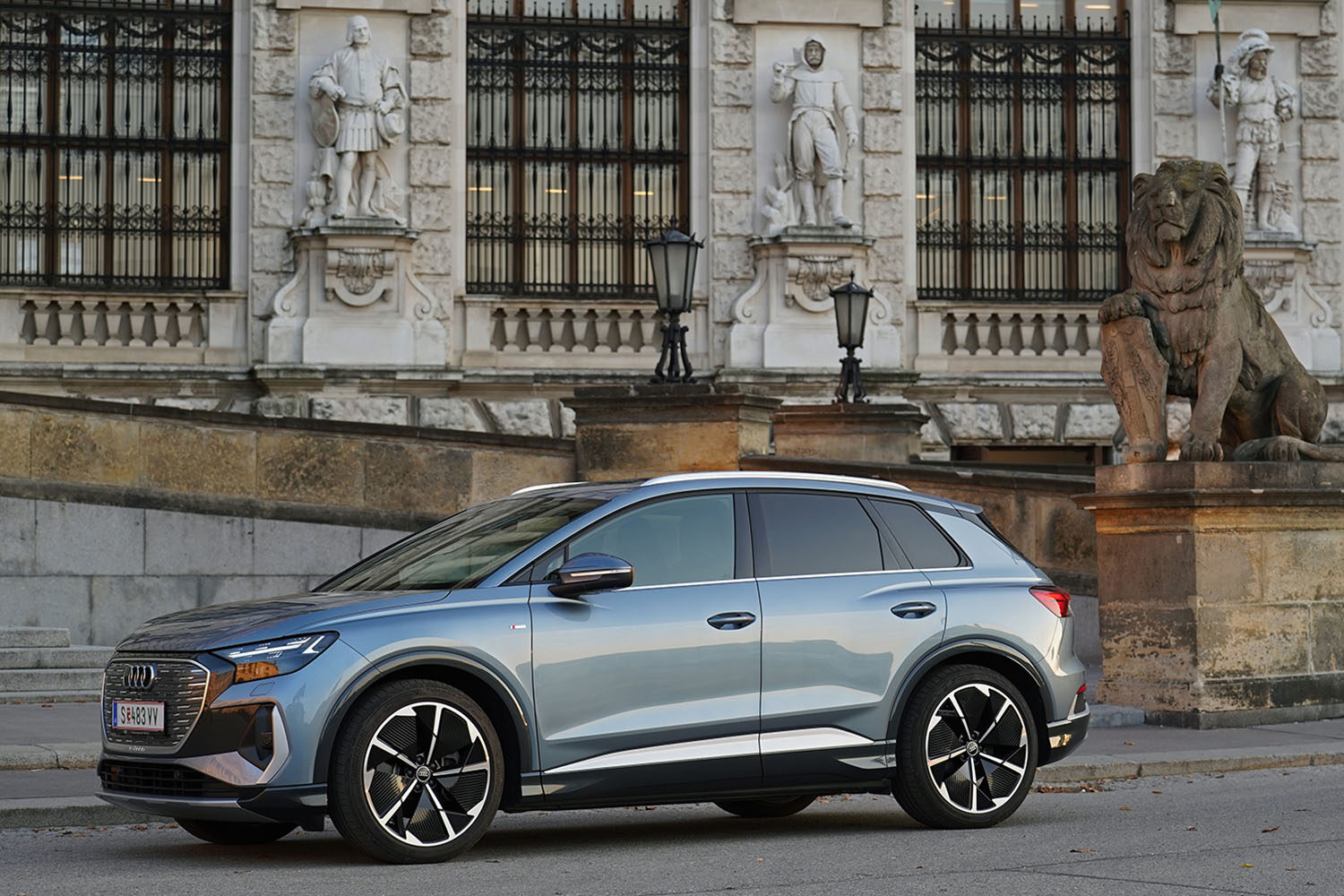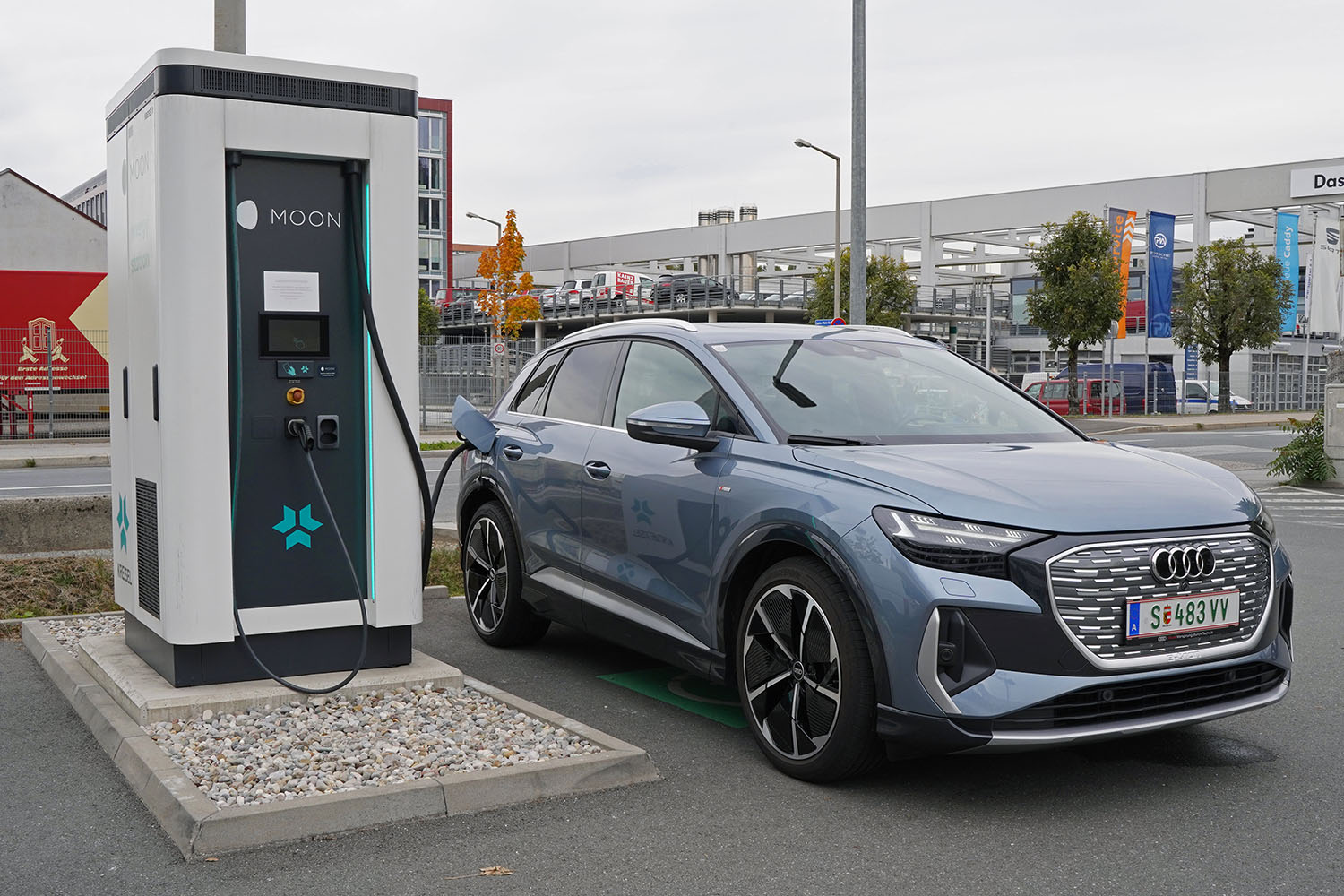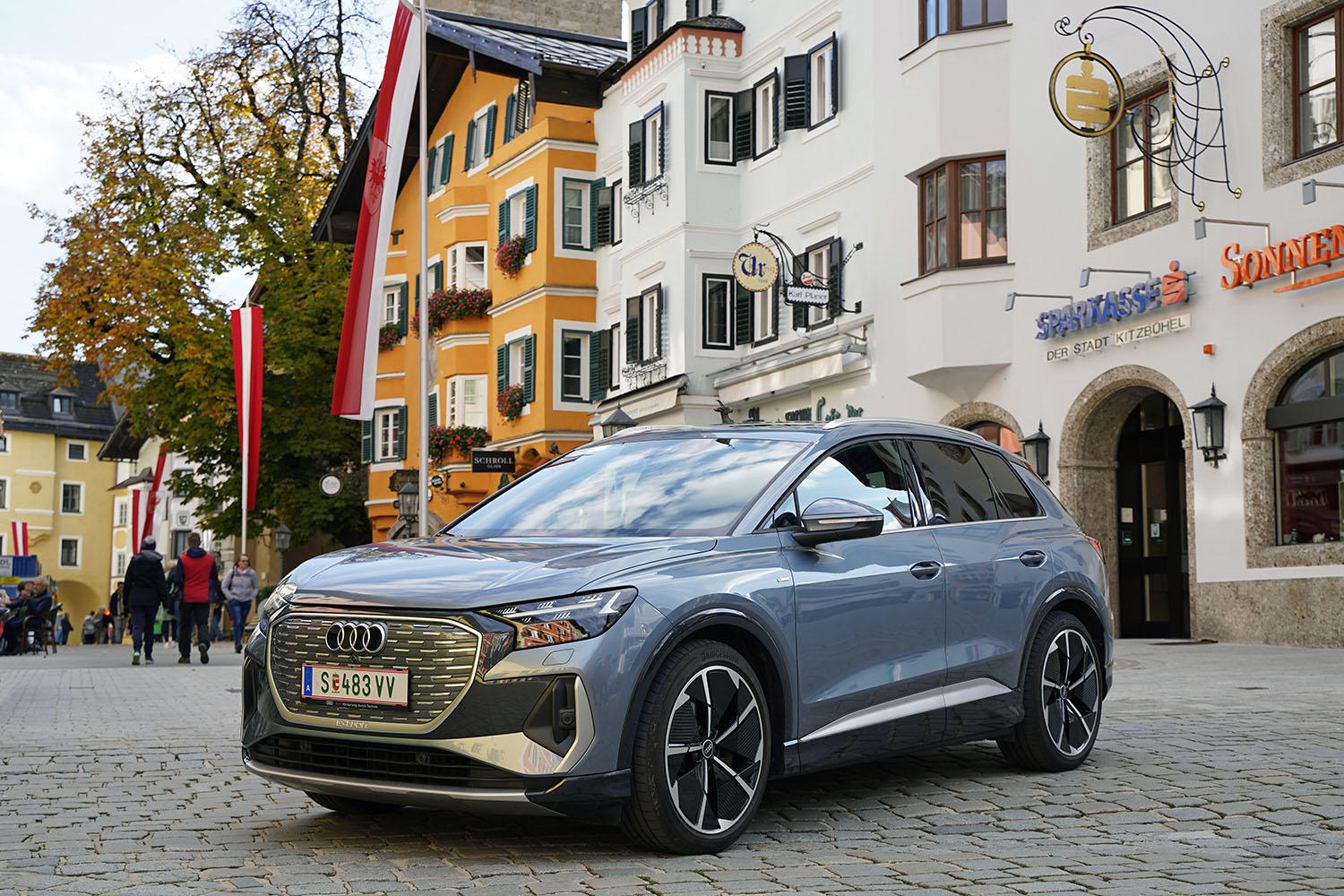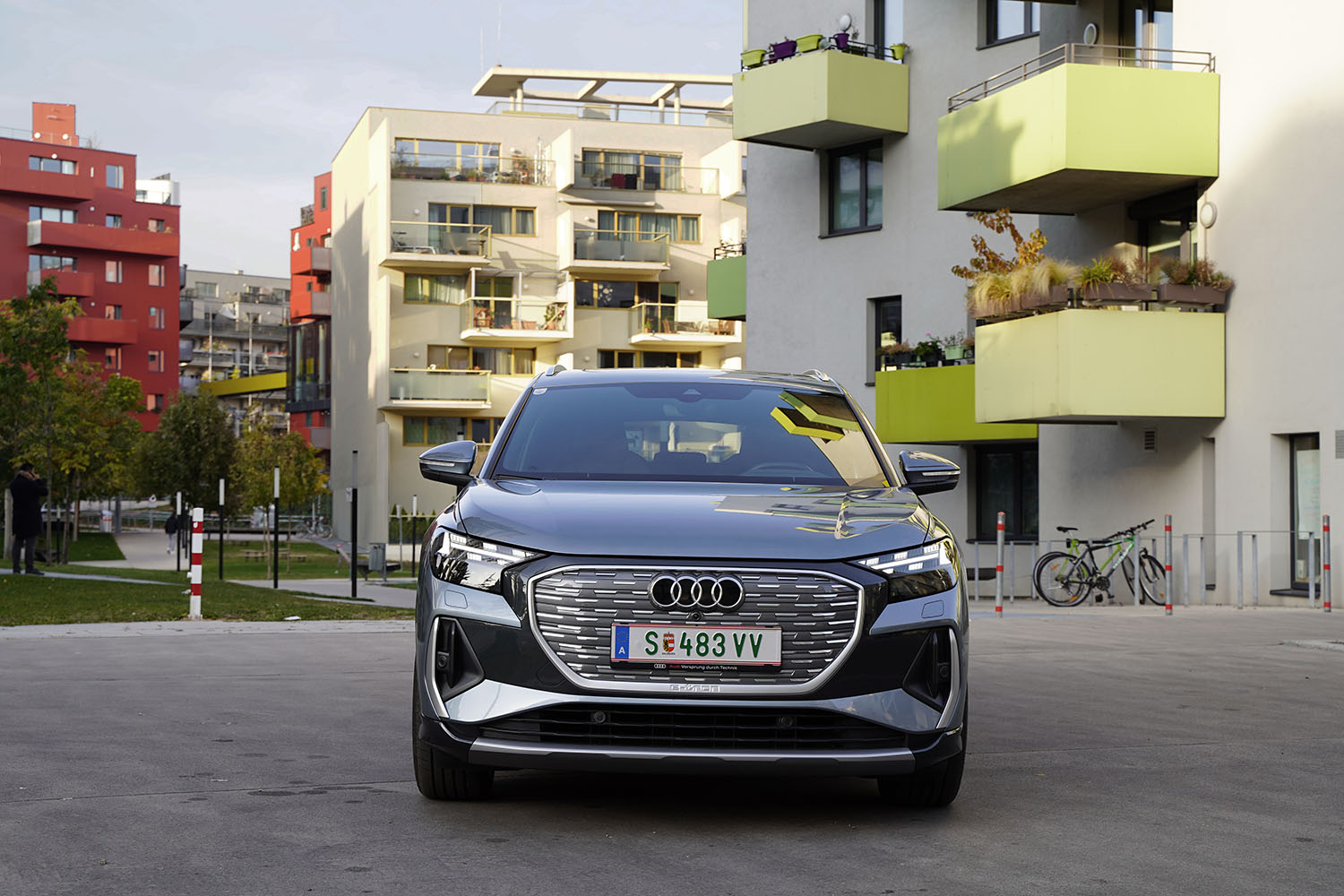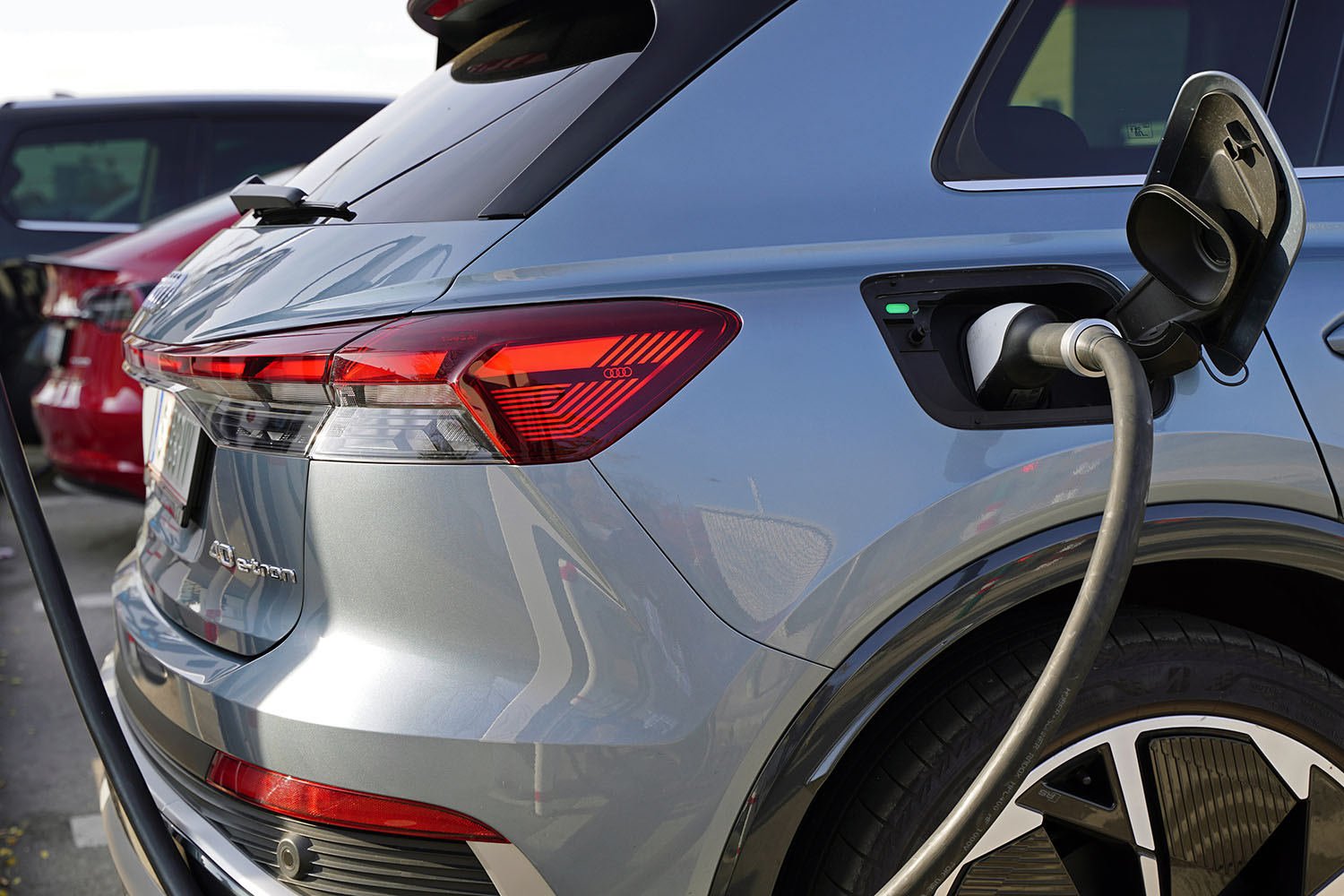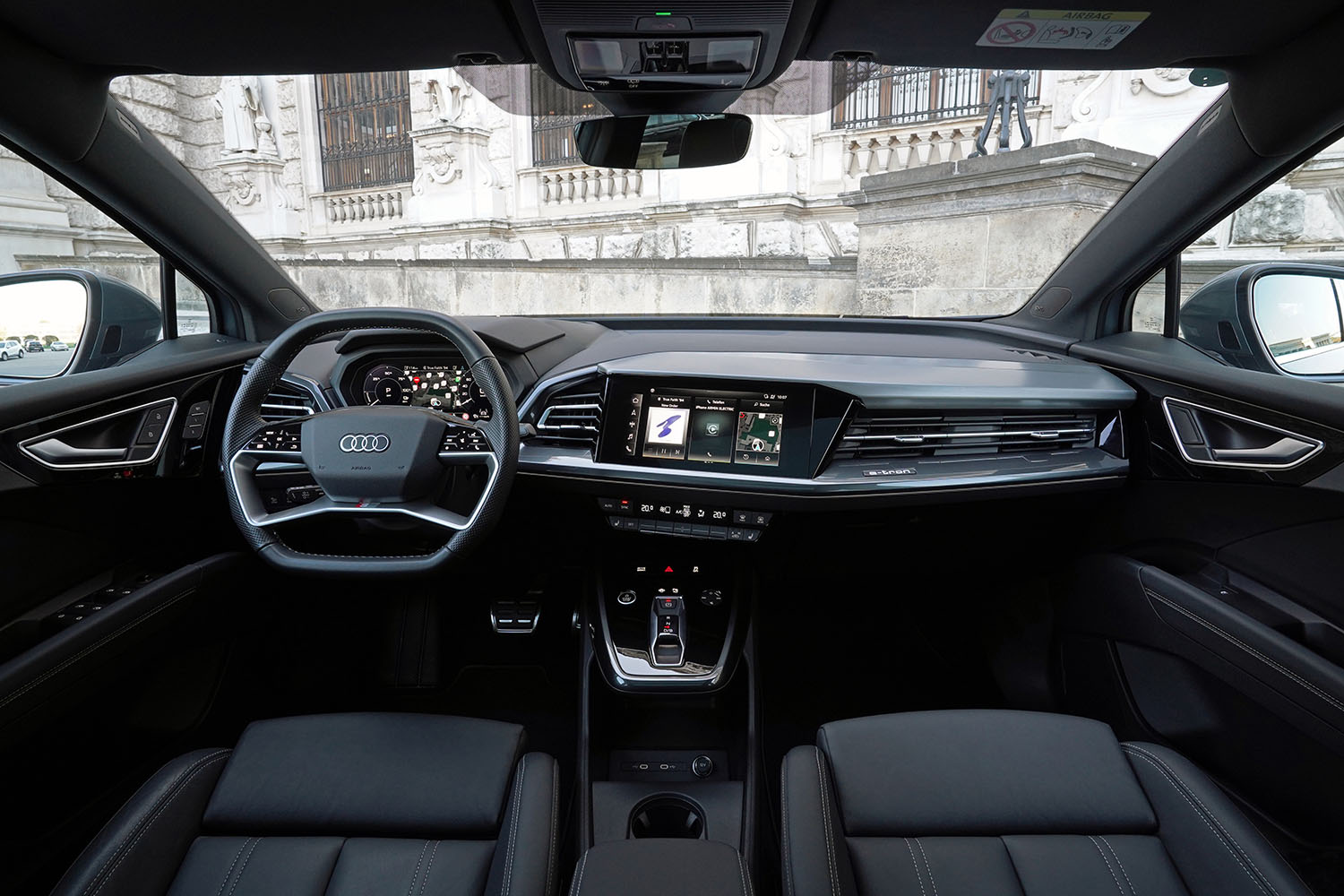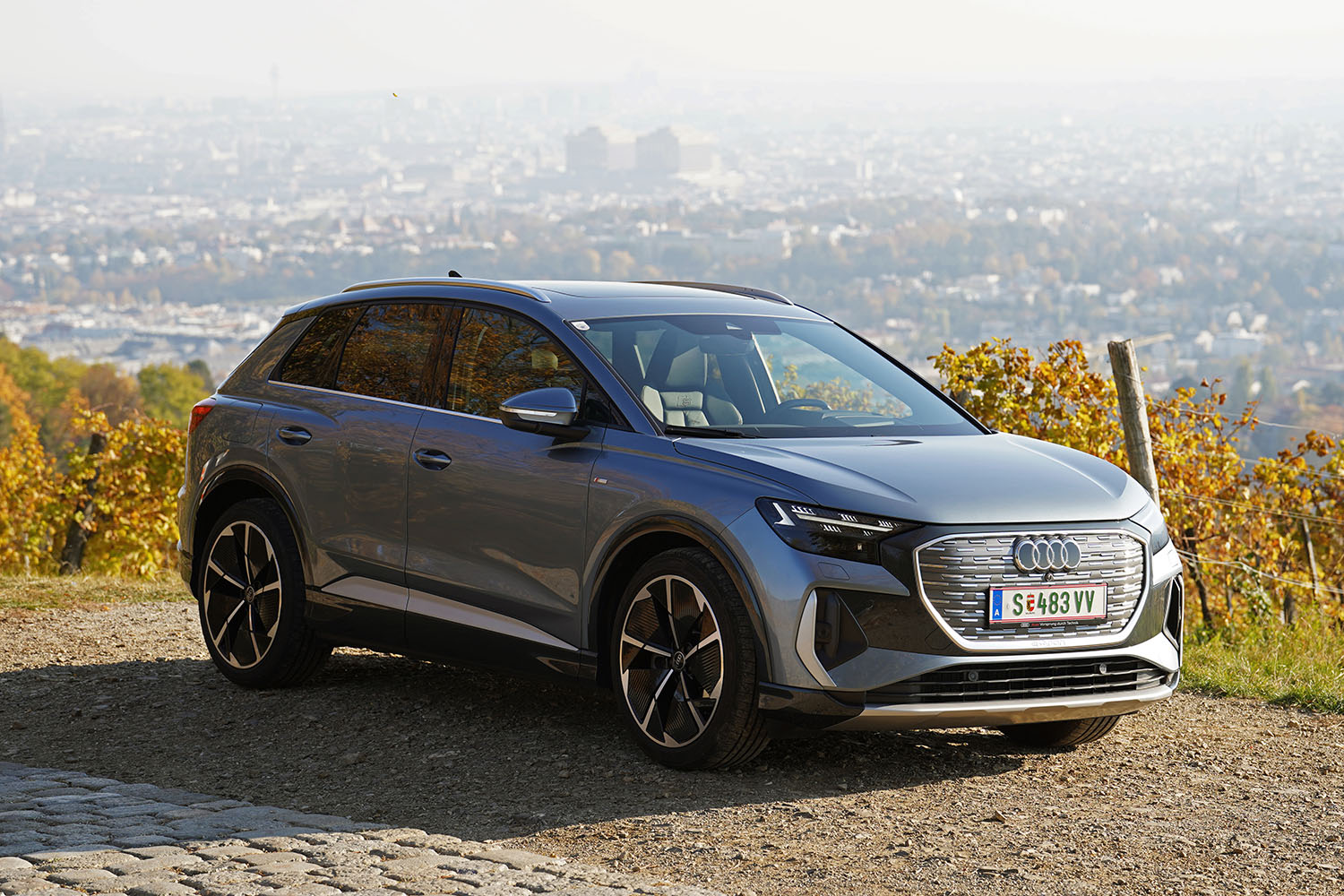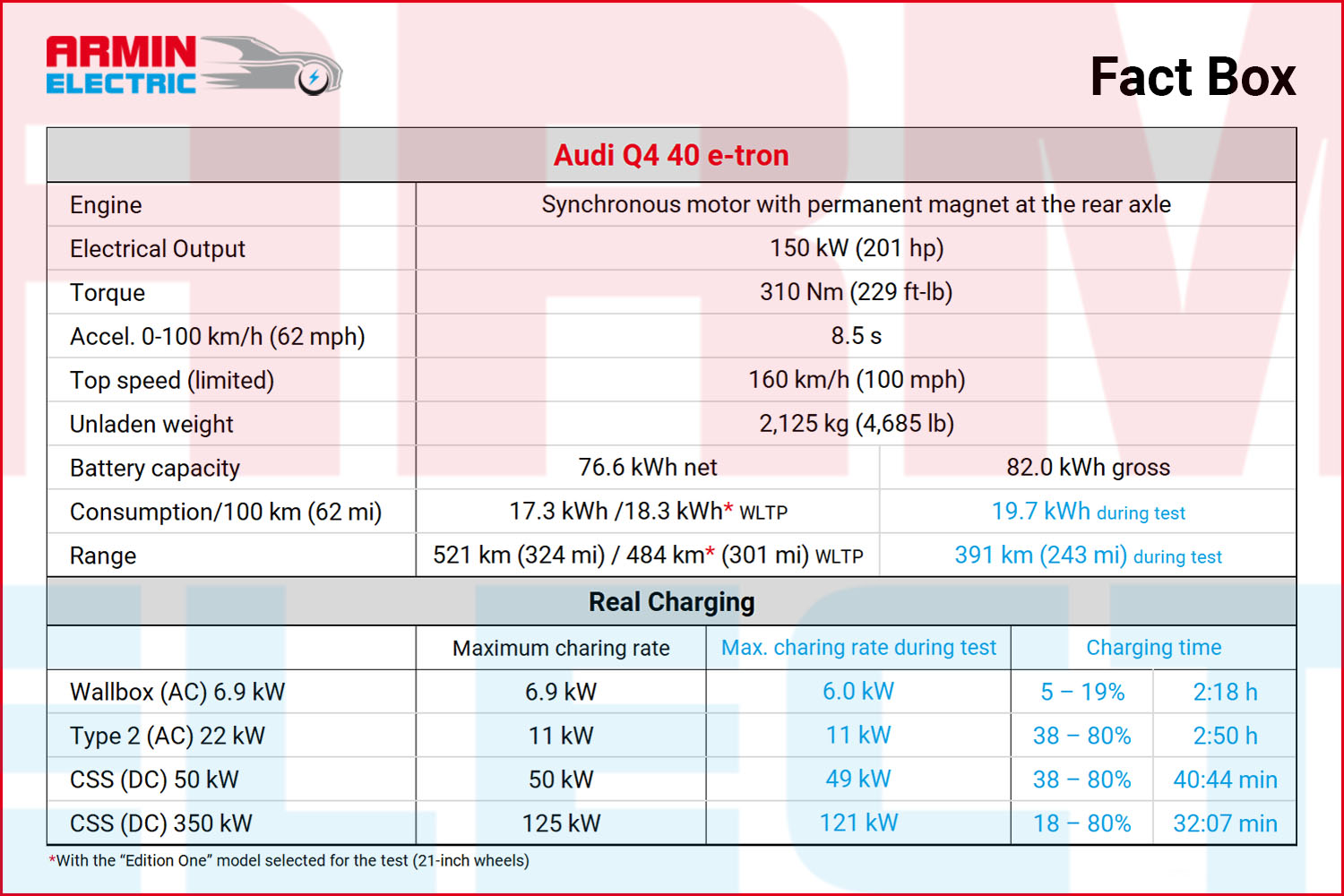Kitzbühel | Vienna – With the Q4 e-tron, Audi is expanding its all-electric fleet with a compact SUV designed to appeal to a broad clientele. I was able to test the foremost member of the Volkswagen Group’s mid-size trio, which consists of the VW ID.4 and Škoda Enyaq iV, throughout much of Austria…
Founded in 1947 as a wholly-owned subsidiary of Volkswagen AG, Porsche Holding Salzburg is the largest automotive distributor in Europe. As part of the holding, Porsche Austria acts as the Austrian general importer for the Volkswagen brands VW, Audi, Seat, Škoda and Porsche. The Porsche Inter Auto car dealership chain, which is part of the group, sells the vehicles at 53 locations throughout Austria.
I was able to pick up the rear-wheel drive Audi Q4 40 e-tron “Edition One” in Geyser Blue, with its aero-design 21-inch wheels and flared wheel arches, directly from the headquarters in Salzburg last fall. The 82 kWh battery of the 150 kW (204 hp) e-SUV had already been fully charged at Moon Power’s in-house Kreisel Power Charger so I could drive it straight home to the Pillersee Valley.
STARTING THE ELECTRIC JOURNEY AT THE FOOT OF HAHNENKAMM MOUNTAIN
On my drive from the winter playground of Kitzbühel to the big city, I set out to discover whether it was possible to get specifically from the parking lot of the Hahnenkamm ski lift to Vienna’s western-most 17th district on one battery charge. Not least because this route has a certain relevance for the Audi Q4 e-tron’s target buyer, who might go by the motto: “Don’t let refueling stand in the way between you and your vacation home.”
No sooner said than done, I headed to Kitzbühel with the electric SUV to fill up at the 50 kW Smatrics fast-charging station at the foot of Hahnenkamm. Normally, the DC charging is most efficient up to 80 percent SoC, as charging power drops sharply thereafter. For the test, however, a full drive battery was necessary. So, I started the CCS charging process at 75 percent. After exactly 53:33 minutes, 20 kWh were delivered and the battery was full. Again, charging an already quite full battery to 100 percent does have its drawbacks. But the magnificent view of the Kitzbühel Streif, the venue of the annual Hahnenkamm race, made it worth the wait.
THROUGH GERMANY TO THE WESTAUTOBAHN
The journey first took me via St. Johann in Tirol and Lofer to the German border. The dynamic handling system built into the car allowed me to adjust the vehicle’s tuning specifically to my needs. For the drive to Vienna, I selected the “comfort” mode, which triggered a noticeable response in the chassis. This comfortably ironed out most of the bumps. The system also regulates other vehicle characteristics, such as the response of the steering and the motor.
Upon exiting the “Kleines Deutsches Eck,” the small Alpine region of Germany that juts into Austria, I reached the A1 road in Wals. In the central 11.6-inch touch display, the navigation system’s route planner showed me which stops I should make to reach my destination in the fastest possible time. This time, it recommended I take a 19-minute stop after 179 kilometers (111 mi) at the 150 kW ultra-high-speed charging station at OMV Blindenmarkt. You can also choose to have the map of the navigation system displayed in the digital 10.25-inch instrument panel. Or, you could choose to display information on the Adaptive Driving Assistant, which adjusts speed and safety distance based on the speed limit and route. In perfect conditions, the car keeps to its lane without any steering wheel movement. In the test, this functioned perfectly all the way up to the system’s limits.
As the journey progressed, the range forecast became increasingly optimistic, so I decided to try driving straight through to Vienna. I reached the Steinhäusl junction, the highest point toward the end of the trip, with 11 percent SoC and a predicted range of 40 kilometers (25 mi) remaining. I still had 31 kilometers (19 mi) to go.
However, the goal of the test was to keep to the prescribed speed, not to drive as sparingly as possible. That plan nearly worked, but since the range reserve on the A1 to Pressbaum continued to decrease at 130 km/h (81 mph), I decided to reduce the speed gradually to 110 km/h (68 mph) in order to arrive safely and without a charging stop.
LANDING IN VIENNA WITH 5 PERCENT
After four and a half hours of driving (including a short break) I had successfully completed the 369 kilometers (229 mi) from Kitzbühel to Vienna on one charge. I was in front of a good friend’s house on the outskirts of Vienna’s 17th district. The battery level was 5 percent, and the predicted remaining range was 20 kilometers (12 mi). The average consumption was 19.0 kWh/100 km (62 mi). This was remarkably low considering the high motorway speed of 130 km/h (81 mph).
CONSUMPTION-OPTIMISED AERODYNAMICS
The vehicle owes its low consumption partly to its sophisticated aerodynamics, which give the Audi Q4 e-tron a cd value of 0.28. The decisive factor here is the contour, which narrows toward the rear. The cooling air vents open only when necessary, keeping the car’s surfaces fully streamlined whenever possible. The underbody is similarly smooth. Audi even covered the rear suspension’s control arms to optimise aerodynamics. The rear end of the underbody is formed by a wide diffuser that reduces lift on the rear axle. Altogether, these features are meant to save about 25 kilometers (15.5 mi) in range.
FIRST DAY IN VIENNA
In my friend’s garage, next to an American-made electric car, I discovered a 3-phase Wallbox charger. I was happy to use it on the Q4 e-tron the next morning so that I could start the first day of testing in Vienna without any range anxiety. A charging power of up to 22 kW is possible at a DC charging station for your own home. With a current of 10 amperes, it was 6.9 kW in this case. I achieved an average of 6 kW when charging and so the battery was charged from 5 to 19 percent in 2:19 hours. Included on the day’s agenda, alongside the city center and the Naschmarkt, were some of Vienna’s newer residential areas, Nordbahnviertel and Sonnwendviertel.
ULTRA-FAST CHARGING WITH A HIGH POWER CHARGER
After driving 25 kilometers (15.5 mi) through the city, I reached the Smatrics charging station at the Verteilerkreis – an important roundabout in Vienna’s 10th District, Favoriten. The station was built in May 2018 in conjunction with Wien Energie and was the first ultra-fast charging location in Austria. According to current data from the company Smatrics EnBW, another 150 charging points will be added to the nearly 250 existing ones by the end of 2022. These so-called High Power Chargers (HPC) will have a charging capacity of up to 300 kW. By 2030, Austria’s largest public charging network will add 100-150 additional HPC charging points every year.
During the lunch break, the Audi’s high-voltage battery increased from 15 to 80 percent SoC in 38:51 minutes. In the process, 51 additional kW were added to the tank. With a maximum charging power of 95 kW, there was still a little room for improvement considering the 125 kW possible with the Q4 e-tron. The Q4 40 e-tron possesses the larger of the two batteries available for the EV, with a net capacity of 76.6 kWh (82 kWh gross). This has twelve cell modules with active thermal management and external cooling via the base plate.
A CLASSIC INTERIOR WITH PLENTY OF SPACE
Despite the novelty of the vehicle, you’ll know that this is an Audi right when you get in. Some might even expect the interior of an electric car to be a bit more futuristic. But Audi fans will feel right at home from the start. The feel of the double-spoke steering wheel is extremely modern. The use of the touch surfaces by tapping and swiping was easy to familiarise myself with. The haptic feedback and the delineation of the individual areas by slight elevations was helpful. Otherwise, everything was as usual in terms of operation. The new MBE (e-drive kit) platform, on which the Volkswagen Group’s compact electric SUVs are based, allows for a new layout in the Q4 e-tron. The powertrain and high-voltage battery require little space, giving four passengers enough room to think they’re in a luxury-class SUV. In addition to the spaciousness, passengers will also enjoy the Sonos Premium Sound System, with its 580 watts of power and ten high-quality speakers, including a subwoofer. The whole system is controlled via a specially developed sound algorithm for an authentic listening experience. The trunk capacity of 520 liters, which can be expanded to 1,490 liters by folding down the divisible backrest, ensures there is also plenty of room for your luggage.
Of course, there was more to be done in the grandiose capital, and I couldn’t miss out on a visit to the classic Hotel Sacher. After a friendly reception, I treated myself to an original Sacher-Torte with whipped cream and a Sacher Melange, ending the day with some famous coffee and cake.
SUSPENSION TEST ON THE LEGENDARY VIENNA HIGH ROAD
On the second day, a test on the notorious cobblestone stretch of the Vienna Höhenstrasse was on the agenda. The winding route towards the Kahlenberg mountain starts just above the famous wine taverns of Grinzing shortly after the sign “Wien Ende”. From the first 180-degree bend, it was clear to me that the Q4 e-tron is not just a comfortable touring vehicle. The roadholding was phenomenal even without the optional electronic damper control. The car felt literally glued to the road with its 15 millimeters lowered sports suspension. What limited the E-SUV’s cornering speed was not the chassis, as I would have expected, but rather the modest motor. The steering, which became more direct as the steering angle increased, further showed off the sporty handling.
Arriving at the fork in the road between Kahlenberg and Schloss Cobenzl, I turned left toward Himmelstrasse. At a well-known vantage point in the Sievering vineyards, I caught a magnificent view of the city in its fall colors. The next day, I started the journey home to Tyrol heading north via the Donauufer Autobahn with a battery level of 18 percent. For the approximately 200 kilometers (124 mi) covered in the past two days in Vienna, the average consumption was 20 kWh/100 km (62 mi). The road led me to Stockerau, where after 23 kilometers (14 mi) I made the first charging stop at the Smatrics fast-charging station located at the McDonald’s.
CHARGING STOPS ON THE WAY BACK TO TYROL
Arriving with 13 percent SoC, I was able to charge to 80 percent at the 300 kW charging station with a maximum charging power of 113 kW in 37:12 minutes. Then onto 90 percent. Here, I came much closer to the Q4 e-tron’s maximum charging power of 125 kW than I had at the Verteilerkreis on my first day in Vienna. I then drove west on the S5 and rejoined the A1 via the S33 near St. Pölten. The augmented reality head-up display proved to be quite practical, allowing navigation icons and other information to appear directly in the field of vision, as if floating above the road.
During another charging stop at the Smatrics 350 kW charging station in the parking lot of the McArthurGlen Designer Outlet Salzburg, I encountered some initial trouble, but then reached the highest charging power of the whole testing period. I began my first attempt at 6 percent SoC, but only achieved a maximum charging power of 31 kW for 22 minutes. Moving to another charger with 121 kW, I was able to charge from 18 to 80 percent in 32:07 minutes. In that time, 47 kWh flowed into the tank.
When driving at night, the brightness of the matrix LED headlights is impressive. The 16 individual LEDs illuminate huge areas of the road and its surroundings, making it nearly bright as day without blinding other drivers. Initially, it was almost a little irritating when parts of the road suddenly lit up, but I quickly got used to the advanced lighting technology. In the end, I was thankful for the excellent visibility on the way home through the Saalach valley at night.
ARMIN ELECTRIC CONCLUSION
Throughout the test, the Audi Q4 e-tron proved to be a well-balanced electric vehicle with a wide range of functionality. On the one hand, it was very comfortable for long trips. On the other, it was also convincing in sportier, more ambitious use with its outstanding roadholding. The 150 kW motor of the test vehicle did not quite keep up, but it is more than enough for everyday use. With a consumption of 20.9 kWh/100 kilometers (62 mi) on the 960-kilometer (597 mi), motorway-heavy journey from Kitzbühel to Vienna and back, the small e-tron proved to be quite fitting for travel. 300 additional test kilometers (186 mi) on major roads with an average consumption of just 16.0 kWh/100 kilometers (62 mi) underscored the high efficiency of the compact e-SUV.
All in all, a very well-rounded package, but with one drawback: Audi’s notorious pricing. While the base price of the Audi 40 Q4 e-tron is currently 50,243 Euros in Austria (£46,065 in the UK, $43,900 in the US), still within a reasonable range, the retail price of the tested version, 73,000 Euros, is a hard pill to swallow for a compact SUV. On top of that, the usual standard features in this price range, such as inductive smartphone charging, an electric tailgate and a rear-view camera, were not included. But, for those not deterred by the price and some of the missing features, the reward is a top-notch EV—a joy to drive that truly whets the appetite for electromobility.
Text and photos: Armin Hoyer – arminelectric.com
Photos of Armin: Lunte
Translation from German to English: Ethan Shenhar

